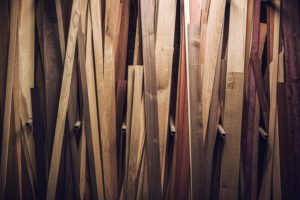
The answer is through grading. Grading helps buyers know what to expect when ordering wood. It helps them make decisions that will affect the appearance and cost of their project. It also helps sellers to set fair prices based on availability and demand. Wood grading provides a mathematical system for determining the value and usability of wood, as well as a set of terms for communicating about it clearly.
The following is a general overview of the wood grading process, along with some common hardwood grades and terminology. (Softwoods have their own grading system). It should be noted, however, that there is no one universal grading system. Characteristics vary from species to species, and what is acceptable will vary according to application. Some sellers have their own proprietary grading systems, which may or may not incorporate the following terms. If in doubt, consult with the seller or with one of the many industry associations.
Background
With the development of industrial milling techniques in North America, lumber was processed and sold in greater quantities than ever before. There were, however, few industry standards to regulate the trade. This meant very little consistency in the market. Buyers could not be certain that they were getting a quality product for their money, and sellers could not be certain that they were getting a fair price for their lumber.
Around the turn of the 20th Century, the National Hardwood Lumber Association (NHLA) was born, largely out of a need for consistent standards across the United States lumber industry. A number of industry associations have since been formed to set more detailed standards for specific applications, such as flooring, and species, such as oak and maple. Most of these have adapted their guidelines from the NHLA criteria.
Grading: The Basics
Wood is graded at lumber mills based on a number of factors. The first of these is size – the length and width of a board. While thickness is of course important to the woodworker, it’s the surface area of a board that determines its grade. After a board’s length and width are determined, an inspector then measures the percentage of the surface area that is marred by defects, including knots and knotholes, checks, splits, wormholes, rot, and stains. The area that is free of such defects is called clear wood or clear cutting, and constitutes the usable portion of a board. While both sides of a board are assessed, it is the poorer of the two sides that will ultimately determine a board’s grade.
The inspection process involves precise measurements and calculations, but the basic idea is that the greater the percentage of clear wood, the higher the grade; and the higher the grade, the greater the cost. These differentials are not insignificant – jumping up to the next grade could double a project’s cost.
NHLA Grading
The following are the standard grades of the NHLA. Often, a seller will bundle several grades together and label the bundle accordingly. When the phrase Or Better appears alongside the grade, it is meant to assure the buyer that every board in that bundle is at least of that grade, with some higher grade boards included.
Firsts and Seconds (FAS) – Boards are a minimum of 6” wide and 8’ long. At least 83 1/3% is clear wood, with clear wood portions a minimum of either 3” by 7’ or 4” by 5’. This applies to both sides, making this ideal for applications such as furniture, where the wood will be visible on either side. FAS is the highest and most expensive grade.
Firsts and Seconds One Face (F1F) – Boards are a minimum of 6” wide and 8’ long. One side meets the clear wood standards for FAS, while the other meets those of No. 1 C (see below). F1F is often bundled together with FAS, and is especially suitable for applications where only one side of the board will be visible.
Selects – Similar to F1F, but smaller. Selects boards are a minimum of 4” wide and 6’ long. At least
83 1/3% is clear wood on one side, while the other should meet clear wood standards of No. 1 C. Like F1F, selects are often bundled with FAS.
No. 1 Common (No. 1 C) – Boards are a minimum of 3” wide and 4’ long. Clear wood makes up between 66 2/3 to 83 1/3% of the board, with clear wood portions at least 3” by 3’ or 4” by 2’. This applies to both sides.
No. 2A Common (No. 2 AC) – Boards are a minimum of 3” wide and 4’ long. Clear wood makes up between 50% and 66 2/3% of the board, with clear wood portions at least 3” by 2’. If one side of a board falls within these parameters, it is graded as No. 2 AC, even if the opposite surface meets the standards for a higher grade.
Other Grading Systems
While the NHLA grading system is the most widely recognized, industry associations have developed grading criteria based on traits relevant to their products. This makes sense. Grading based on the appearance of both faces of a board is important if you’re building furniture, or need both sides visually clear. Bear in mind that the terms used in one grading system may not translate to another.
Flooring Grades
Flooring manufacturers are less concerned with board length, whereas dimensional stability takes on added significance. With hundreds or thousands of strips fit together, the amount the pieces expand and contract will ultimately affect the quality of the floor. Factors such as wood species, milling technique, and color play a significant role in these systems. The percentage of heartwood – hard, old-growth material at the center of a tree – versus sapwood – the softer outer layers of a tree – is also considered, as such factors greatly affect stability and appearance.
While a thorough exploration of all of all the major flooring association grading systems is beyond the scope of this article, an overview of the National Oak Flooring Manufacturers Association (NOFMA) is given below. Be aware that a number of other systems exist, with terms and considerations specific to each association or company. The following is based on information found in the National Wood Flooring Association’s publication Grading and Packaging, (1999).
NOFMA Grading System
Materials are graded based on criteria similar to NHLA standards, with added designations for the way in which the lumber is milled. (For a more detailed discussion of milling techniques, click here.)
Milling Characteristics

Rift Sawn or Rift – The angle of growth rings on endgrain to the face of the plank must be between 30 and 60 degrees on at least 75% of planks. Grain lines must run parallel to the length of the plank. Flecks of medullary rays must be less than 1/16” wide. Rift sawn and plain sawn materials are often bundled together and marked Quarter/Rift Sawn or Quarter/Rift.
Plain Sawn or Plain – No endgrain criteria need be met. Bundles marked Plain Sawn may contain plain sawn, quarter sawn, or rift sawn planks.
NOFMA Grades
Clear Oak – Mostly heartwood. Sapwood up to 3/8” wide may extend entire length of the plank, or sapwood up to 1” wide may extend up to one third of the plank’s length. Defects and discolorations should be minimal. Planks should have generally uniform appearance with some natural color variation acceptable. Standard tongue size is 1/4” wide.
Select Oak – Any combination of heartwood and “sound” sapwood. Some slight milling imperfections are acceptable. Small knots are permitted every 3”. Dark streaks should not extend the length of the plank. Occasional milling burns 1/4" wide or less are acceptable. Some open characters, including checks and wormholes, are permitted – these may require filling. Tongues 1/2” wide are permitted. Note that “Select Oak” is an entirely different designation than NHLA’s “Selects” designation: it is not based on board length.
Number 1 Common Oak – Any combination of heartwood and sound sapwood. Some slight milling imperfections are acceptable. Some heavy dark streaks are permitted. Occasional milling burns 1/2” wide or less and 1/64” moisture-wood-floors/ deep or less are acceptable, provided there are no more than two every 3’. Some stains are allowed, as are some open checks, worm holes, and knotholes, provided they can be easily filled. Large worm holes, long splits, and broken knots wider than 1/2” are not permitted. Tongues 1/4 wide are permitted.
Number 2 Common Oak – Any combination of heartwood and sound sapwood. Some milling imperfections are acceptable. Unlimited natural character marks are admitted, provided they do not affect the soundness of planks and all holes can be easily filled. Milling burns greater than 3/64” deep are not acceptable. A few pieces may contain no tongue.
Conclusion
The above represents just a sample of the many grading systems used in the wood products industry. While there is no universal system, understanding the basic criteria used to grade wood and the terms generally associated with them will take you a long way towards making sound decisions when purchasing wood for flooring and other projects. As always, address any questions to a qualified woodworking professional.



